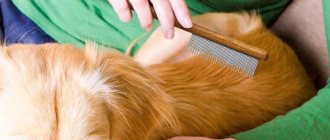During the cold season and also in spring, the problem of combating external parasites among our four-legged friends becomes more urgent than ever. The most dangerous of which for dogs are ixodid ticks, most of which carry Babesia in their saliva, which causes one of the most famous diseases among dog breeders in our pets - babesiosis or piroplasmosis.
Like many other parasitic diseases, babesiosis is more effective in prevention than in treatment. There will be a separate article on our website about what drugs are used to treat this disease. So, let's figure out what methods of protection exist against ticks.
How to treat a dog for ticks
In the last 2-3 years, experts have noted an increase in the population and an increase in the activity of various types of ticks. This is due to an increase in average annual temperature and, as a consequence, warmer winters. As a result, ticks do not fall into a state of suspended animation, or “sleep” during the shortest coldest period. Thus, the duration of their activity period increases every year. This means that pet owners need to remember this threat and promptly provide protection from very dangerous insects. Know how to treat a tick bite on a dog.
The most dangerous period is still spring. The time for ticks to awaken and actively reproduce and patiently search for food.
The danger of blood-sucking parasites
The number of ticks is growing year by year, their habitat area is increasing, and this cannot but cause concern for owners. There are different types of mites (ear mites, dust mites, scabies mites), but the greatest threat to animals and humans are ixodid mites.
Ixodid ticks are carriers of many bacteria and viruses, so literally one bite of such a “bloodsucker” can cause inflammation on the animal’s skin, or even provoke such dangerous diseases as piroplasmosis, typhus, tularemia, borreliosis and encephalitis. And this is a real threat to the health and life of your pet!
Important! It is a mistake to think that only dogs suffer from tick bites, and cats are only carriers of the infection. It’s just that cats become infected less often, and their disease is more difficult to diagnose. But the disease is much more severe.
Consequences of a tick attack on a dog
In addition to the fact that the tick bite itself is quite unpleasant, it can lead to a number of consequences:
- The immediate moment of the bite remains invisible to the “owner”, thanks to the tick injecting an anticoagulant and anesthetic substance contained in the tick’s saliva into the wound. After detaching the tick, a wound remains that can become inflamed and itchy.
- There are many types of ticks in nature. Some species parasitize dogs, causing diseases such as otodectosis (ear mites) and sarcoptic mange (scabies). These ticks, when attacking, multiply on the dog. Thus causing extensive lesions with the formation of constantly itchy, bald, inflamed areas on the skin.
- Another tick that is dangerous from a veterinary and medical point of view is ixodid. Their individuals are quite large and visible to the naked eye and parasitize on the surface of the skin. The main danger of this species is that they are carriers of infectious diseases such as tick-borne encephalitis, piroplasmosis, Lyme disease and others.
IMPORTANT! Ticks carry diseases that also affect humans. Including viral encephalitis. But this disease is not relevant for dogs.
From the above, we can conclude how important it is to timely and effectively treat dogs against ticks. Currently, developers of veterinary drugs offer products that can provide protection against most of the threats and consequences that ticks pose to dogs.
An example of a complex treatment against external parasites is the drug Simparika in the form of chewable tablets. Taking Simparika will provide your dog with protection from fleas, ixodid ticks, otodectic mange, sarcoptic mange and demodectic mange, and will also significantly reduce the risk of contracting vector-borne diseases.
Overalls, vests, bandanas, is there any sense in such protection?
Nowadays, wearing clothes by animals of various styles and even brands is actively gaining popularity. All this would not have been such a success if not for beautiful photographs for social networks and the Internet. But in addition to the aesthetic views of pet fashion, clothing for animals also has practical advantages. One of them is protection against ticks and fleas.
The clothing itself, when worn by the animal, physically prevents ticks from getting onto the animal's body. In most cases we are talking about overalls. Also, often the clothes themselves are treated with sprays against ticks and fleas, while the animal’s body does not come into contact with the drug, without causing allergies or other reactions to the components of anti-parasite products.
Vests are more often processed, sometimes these can be bandanas, for example, when the animal is not used to wearing clothes. In addition to all of the above, there are overalls from the Osso company, which are designed with tick traps, namely these are many folds in places where ticks like to be on the animal’s body, from where it is impossible for ticks to get out, and they die.
Of course, clothing cannot be a complete method of protection against ticks and fleas, but in combination with other means it can provide reliable protection for your pet.
Preparations for oral administration, protection as prevention
Oral tablets against ticks and fleas are a popular way to protect dogs and are the choice of a large number of dog breeders. A very effective way to prevent ticks. The parasite can land and bite into the animal, but will die before the dog gets sick with piroplasmosis. Of course, none of the drugs provides 100% protection against external parasites, but tablets are still considered one of the most effective ways to protect against ticks.
There is also information about giving tick tablets at the moment when the tick has already attached itself to the dog in order to cure piroplasmosis in the early stages. This, of course, is a myth, and it is not advisable to do so, since giving pills if piroplasmosis is suspected makes it difficult to diagnose using a blood smear, masking the symptoms of the disease.
Effective Pill Brands
Although tablets are considered an effective way to combat ticks, their choice is not at all large: Simparica, Bravecto, Nexgard and Comfortis. Let's take a closer look at each of them.
Simparica . It is effective 12 hours after giving to the animal and provides protection against ticks, ear mites, sarcoptic mange and demodectic mange, as well as helminths for up to 35 days or 5 weeks. At the same time, as when giving other tablets, there are no restrictions on bathing; it is easily tolerated by a large number of dogs. Due to the need to repeat the administration of the tablet more often than Bravecto, it has a pronounced antiparasitic effect.
Bravecto . Bravecto begins its action 4 hours after administration and acts in such a way that it is activated after a parasite bite and causes the death of fleas after 8 hours and ticks after 12 hours. The duration of the drug is a record 12 weeks. Can be used from 8 weeks of age and does not cause side effects in recommended doses.
Nexguard Spectrum . It begins to act within 3 hours after giving it to the animal, providing lasting protection not only from ticks and fleas, but also from helminths such as roundworms, hookworms and whipworms. Prevents dirofilariasis, which causes mosquito bites. Nexgard must be used monthly.
Comfortis . A drug from the UK that is rarely found on store shelves. This is due to the high cost and standard characteristics of tablets against ticks and fleas.
View in the online pet store petshop.ru
When to treat your dog for ticks in the spring
If active ticks or the symptoms they carry with them are found on your pet in early spring, it means the treatment is late. To prevent this from happening, the main guideline should be the ambient temperature. Ticks begin actively searching for food when a stable temperature of +10°C or higher is established. However, the potential danger of attack arises already at +1°C, when the insects wake up. It is recommended to take care of protecting the animal from this moment on.
Means and methods of protection
There are several methods for preventing tick attacks practiced by owners. The simplest measures include:
- Wearing special clothing is a mechanical way to prevent ticks from attacking your dog. If the dog is accustomed to wearing clothes, then a jumpsuit with ties around the paws can protect it from the penetration of only some individuals of Ixodid ticks. After all, ticks can stick to the area of the pads, and between the toes, on the head, on the mucous membranes of the mouth and genitals. And small individuals can easily penetrate under clothing. Therefore, this method can only be used as an additional method in combination with drugs. It is better to choose light-colored clothing - ticks are better visible. There are models equipped with special traps from which ticks cannot escape.
- Inspection and combing. Once on the coat, parasites can wander throughout the dog’s body until they reach their favorite places (eyelids, neck, ears, withers). You need to examine your pet immediately after each walk.
- The use of strong-smelling essential oils of clove, mint, wormwood, geranium, vanillin solution. Their smells should repel blood-sucking insects. But in practice this does not work well, since solutions sprayed onto wool will only act until the esters have evaporated, and this often happens before you get to the place of your walk.
Such simple folk measures do not provide any guarantees and are most likely ineffective.
A more reliable way to protect your pet is to use special medications that protect against external parasites. Let's consider: what is the best way to treat a dog against ticks. It must be remembered that these products should not only be destructive to parasites, but also not harmful to the dog’s body. Therefore, it is important to choose a means of protection responsibly and adhere to the following recommendations:
- Carefully study the instructions for the selected drug;
- Take into account the physiological state, age, clinical condition, individual characteristics of the dog;
- If it is difficult to understand all the nuances, seek advice from a veterinarian.
Remedies for external parasites can be divided into two large groups:
- internal or systemic drugs
- external or contact-acting drugs
Sarcoptoid mite
It is often confused with scabies because it also causes scabies. The routes of infection and symptoms of infection with these two types of parasites are identical. The animal itches a lot and injures the skin with its claws. In these places, pustules form, inflammation, and dandruff appears. Without treatment, bald spots appear on the body of an infected animal, and exudative dermatitis may occur.
The pet begins to weaken, its protective properties of the body decrease.
To carry out diagnostics to detect the parasite, scrapings are taken.
Owners are interested in what inexpensive anti-tick medications are available for dogs. If your pet is diagnosed with sarcoptic mange, bathing with tar soap is recommended. This option is the most economical, but quite effective. You can also use antiseborrheic shampoos, for example Oxymed, Animall Vetline, Veterinary Formula.
Pills
The most modern among systemic drugs and developed relatively recently are tablets of the isoxazoline group. They have become the parasite prevention choice for many veterinarians and dog owners. And they allow you to protect your pet from fleas and ticks, including ixodid ticks.
Let's consider their mechanism of action using Simparika chewable tablets as an example. Simparika tablets are an innovative development of one of the leading international manufacturers of veterinary drugs. Advanced technologies have made it possible to create a drug with a wide spectrum of action against external parasites and at the same time with good tolerance for the body of dogs.
The component sarolaner has a destructive effect on parasites. During the first three hours after taking the drug, its active substance is distributed throughout the dog’s body, protecting both the skin and mucous membranes of the animal from parasites. Contact of sarolaner with parasites causes progressive paralysis of their nervous system and, as a result, death.
The use of Simparica chewable tablets has the following benefits for protection against parasites:
- Unlike external contact agents, it is not washed off when bathing, including using shampoos.
- It is not present on the surface of skin and fur, therefore contact of humans and other pets with the active substance is excluded. There is no risk of poisoning when licking fur. This is true, for example, for cats living next to a treated dog, or for puppies living next to a nursing mother.
- Belongs to 4, the lowest hazard class
- Approved for use for nursing and pregnant dogs, as well as for puppies from 2 months of age.
- Unlike external drugs, it also protects mucous membranes.
- Flavoring additives make Simparika tablets very attractive to dogs, and the treatment process for parasites does not cause difficulties.
- The action of the drug is complex; Simparika is active against most external parasites.
Tablets in the fight against ticks
Oral medications are new to this category of drugs. But the high effectiveness of the products has ensured their high popularity among dog lovers. Do not think that you will have to force the tablet into the animal’s mouth. These products are produced in the form of rounded pieces that have an appetizing appearance and aroma. The dog will be happy to eat a healthy treat. You can feed the tablet by hand or add it to food. The active components of oral medications destroy fleas and ticks, parasites localized in the ears. The effect of the drug is observed within half an hour after use. A significant advantage of the tablets is that their effectiveness is independent of external influences. Walking in the rain and swimming do not affect this indicator. The disadvantages of tablets include:
- the need for accurate dosage calculation;
- the possibility of allergic reactions and side effects;
- impossibility of use for kidney and liver diseases;
- age restrictions;
- high price.
The best products in this category are considered to be tablets: Frontline, Comfortis, Bravecto.
Drops on the withers
They have a liquid base and come in the form of pipettes. The drugs are applied in drops to the dog’s skin in the withers area. The effectiveness of the drug will greatly depend on compliance with the rules of use. Contact action drops are fat-soluble and for best effect they need a lipid layer that is located on the surface of the animal’s skin. Thus, before applying the drops, the dog should not be bathed for at least 2 days before and for 2-3 days after treatment - since the drops must be absorbed and distributed in the lipid layer. Such preparations should be applied strictly to the skin, spreading the fur in places inaccessible for licking (withers).
Due to long-term distribution over the surface of the lipid layer, the effect of the drops reaches its maximum 2-3 days after application. Therefore, you should not expect a quick acaricidal effect immediately after applying the drug - you must wait 24-48 hours for activation. After applying the drops, you need to limit your pet’s contact with children and other animals until the drug is completely absorbed. Information about this is usually specified in the instructions.
Sprays
The spectrum of activity against parasites, the speed of action and the principle of operation depend on the active substance included in the composition. But all sprays are external preparations. The disadvantages include the complexity of the dosage, and, as a rule, a short period of action. As well as a decrease in efficiency upon contact with water
It is better to apply sprays outdoors - this will save both the owner and the pet from inhaling an extra portion of active substances.
Powder preparations and shampoos
You can prevent the danger with the help of special powder. For the most part, these products are not intended for preventive treatment, but to combat existing insects. The active component of powder preparations is pyrethroid. To ensure the desired effect, the product is applied to the wool and rubbed into it. Distribute the powder carefully, excluding the possibility of the drug getting on the mucous membrane of the eyes. Many dog owners use special shampoos. Composition of this product:
- qualitatively cleanses wool and skin from dirt;
- distributes toxic components;
- provides nutrition to cells.
The active substances are absorbed into the hairs and dermis, repel insects, and destroy adults and larvae. You can use shampoos to prevent and get rid of parasites. The advantage of these products is their gentle effect, the ability to use them for puppies, pregnant and lactating bitches. The following shampoos are very popular: Bars, Dana, Fitoelita.
What is the best way to treat your dog for ticks?
A veterinarian familiar with the individual characteristics of your dog will advise you on the best remedy that is right for you. However, the above information about the mechanism of action, the pros and cons of the proposed drugs will allow you to make the choice of a suitable remedy yourself.
When choosing one drug or another, it is important to remember that any drug has limitations and features of use, so before using it, it is important to carefully read the instructions. And even the most effective remedy cannot provide a 100% guarantee and does not negate careful attention to the pet and its condition. Examine your dog after a walk, pay attention to changes in behavior and the appearance of nonspecific symptoms. This will allow you to make a timely decision to contact a veterinary clinic.
Ticks are carriers of dangerous diseases
Parasitiform mites are not permanent ectoparasites. They may be without food for certain periods of time, waiting out unfavorable environmental conditions. With warming, they again return to an active way of life in search of prey. Among their victims are mainly wild fauna - rabbits, mice, squirrels, foxes, etc. These animals are often reservoirs for the development of a huge number of pathogens. That is, potentially dangerous microorganisms or viruses can circulate in their populations and not cause the manifestation of the disease itself.
Feeding on infected blood, the tick absorbs a portion of pathogens, whose concentration increases over time in direct proportion. We are not talking about any one specific pathogenic agent. In the intestines, salivary glands or other organs of an arthropod there may be several different pathogens competing with each other.
As a result, it turns out that one tick that once bites a wild squirrel can infect a dozen domestic animals or humans. For dogs, a bite can be fraught with the development of pathologies, which veterinary medicine carefully examines and tries to prevent.
- Babesiosis (or piroplasmosis). It is caused by a protozoan intracellular parasite that infects an animal's red blood cells, disrupts their function, and destroys them. It is characterized by an acute course and a clear clinical picture: jaundice, the appearance of dark red urine due to hemolysis, a sharp increase in temperature.
- Canine monocytic ehrlichiosis (MES). Caused by intracellular bacteria that infect Bacteria that infect monocytes (a subtype of white blood cells). The course is longer, with less characteristic clinical signs: fever, discharge from the nose and eyes, possible skin manifestations in the form of the appearance of a multiple point red rash.
- Bartonellosis. Caused by intracellular bacteria that infect red blood cells, macrophages, and vascular endothelial cells. They cause red blood cells to stick together, affect the immune system, and provoke vascular inflammation. Manifests: stomatitis, bleeding from the nasal cavity, lameness due to blockage of blood vessels by blood clots, polyarthritis, etc.
- Lyme disease (borreliosis). The causative agent is a bacterium that infects various organs and tissues of a sick animal. Along with babesiosis, it is registered quite often; the disease is also characteristic of humans. Long-term development of the pathology is possible, among the main clinical signs is the appearance of migratory erythema at the site of the tick bite and the penetration of borrelia, which resembles a target. In the future, the diagnosis of lameness is clinically important, since the joints are affected.
Other diseases include tick-borne encephalitis, hepatozoonosis and others.
How to treat a dog after a tick bite
What to do if you did not treat your dog for parasites in time and found a tick attached to it?
- Remove the parasite: put on gloves, then hold the body with tweezers at the very surface of the skin or use a special twister to twist the tick out of the wound with a rotational motion.
- Treat the bite site. How to treat a dog's wound after a tick? – any antiseptic (70% alcohol, brilliant green, alcohol solution of iodine) that is in your first aid kit.
- Contact a veterinary clinic. If you were able to remove the tick, submit it for analysis. The doctor will check the dog's blood for infection with piroplasmosis and babesiosis. These are express tests with quick results. If a positive result is obtained, the pet will be prescribed therapy.
- Monitor the dog even after receiving a negative result for 2-3 weeks. Fever, lethargy, and refusal to feed should alert you.
What to do if the head remains in the dog
It is necessary to remove the tick from the dog's body entirely; leaving its head under the skin is unacceptable. Otherwise, the process of inflammation and suppuration will begin.
The tick's head looks like a small black dot, similar to a splinter. To extract it, use a thin needle. Before carrying out the procedure, the needle must be calcined and disinfected. To prevent the dog from resisting, it is better to numb the area of skin and calmly carry out the extraction. Then the wound site is wiped with a disinfectant solution.
If the parasite's head is deep in the wound, you should seek help from a veterinarian. He can pull it out by making a small cut.
How to properly treat your dog for ticks
It is important not only to choose the right means of protection, but also to apply it correctly. Let's list the main points:
- Strictly follow the dosage indicated in the instructions. It depends on the weight of the animal and must be necessary and sufficient. Simparic tablets are convenient to dose: they are available in six different dosages for dogs weighing from 1.3 kg to 60 kg.
- Apply the next portion of protection on time. Please take into account the expiration date of the product. For example, for drops on the withers this is an average of 2-3 days. And Simparic tablets are maximally active after 12 hours.
- Follow the manufacturer's recommendations specified in the instructions. Studying the instructions is boring, but very important. And it will help to avoid unwanted consequences from taking this or that drug.











